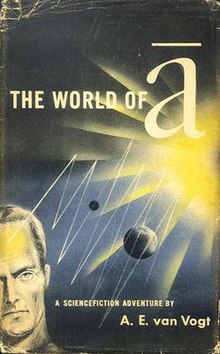The World of Null-A

Cover of first edition (hardcover)
|
|
| Author | A. E. van Vogt |
|---|---|
| Cover artist | Leo Manso |
| Country | United States |
| Language | English |
| Genre | Science fiction novel |
| Publisher | Simon & Schuster |
|
Publication date
|
1948 |
| Media type | Print (Hardcover & Paperback) |
| Pages | 246 pp |
| Followed by | The Pawns of Null-A |
The World of Null-A, sometimes written The World of Ā, is a 1948 science fiction novel by A. E. van Vogt. It was originally published as a three-part serial in Astounding Stories. It incorporates concepts from the General Semantics of Alfred Korzybski. The name Ā refers to non-Aristotelian logic.
Gilbert Gosseyn (pronounced go sane), a man living in an apparent utopia where those with superior understanding and mental control rule the rest of humanity, wants to be tested by the giant Machine that determines such superiority. However, he finds that his memories are false. In his search for his real identity, he discovers that he has extra bodies that are activated when he dies (so that, in a sense, he cannot be killed), that a galactic society of humans exists outside the Solar system, a large interstellar empire wishes to conquer both the Earth and Venus (inhabited by masters of non-Aristotelian logic), and he has extra brain matter that, when properly trained, can allow him to move matter with his mind.
The novel originally appeared as a serial entitled "The World of Ā" in the August 1945 to October 1945 issues of the magazine Astounding Science Fiction, which was edited by John W. Campbell, Jr.
Van Vogt significantly revised and shortened the tale for the 1948 novel release. Like the serial, the 1948 hardcover (Simon & Schuster) and the 1950 hardcover (Grosset & Dunlap) editions were entitled The World of Ā. To reduce printing costs, the 1953 and 1964 Ace Books paperback editions were entitled The World of Null-A, and the symbol Ā was replaced with "null-A" throughout the text.
For the 1970 revision, entitled The World of Null-A, the symbol Ā was permanently replaced with "null-A" throughout the text. Van Vogt added some brief new passages to chapters 10, 24, and 35. The 1970 revision also included a new introduction in which van Vogt defended the controversial work, but also admitted that the original serial had been flawed.
...
Wikipedia
